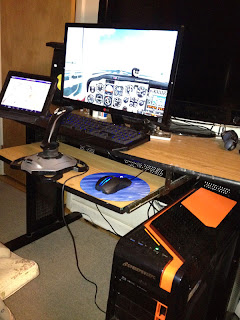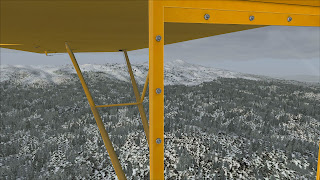The PMDG NGX at KJAC
At 6451ft in
altitude, the small puffs of clouds moving across the runway at Jackson Hole Airport Grand Teton Mountains Wyoming ,
were ready to get back home to sunny California
Like a phoenix the
737 ascended leaving the highly detailed ORBX Jackson Hole airport behind. Climbing over the mountains we were soon hit by
the expected turbulence. Finally a
higher elevation was achieved as turbulence from the mountains dissipated. The
view from the cockpit was amazing.
Active Sky Next had completely recreated the current weather conditions,
utilizing the high definition REX clouds to good effect. The view of the mountains below was
spectacular as this was the next best thing to actually being there. It was hard to hold back a tear of happiness
as I hit the ESC button. But it was time
to end this test flight as a dream had finally been realized!
Milviz Bell 407 flying to ST Maarten
That dream was to
finally conquer the unconquerable FSX and enjoy planes like the PMDG NGX on my
own terms. My older HP labtop could
only run at 2.2 ghz and there no special video card installed. Forget about adding faster RAM or the
likes. I was lucky to be able to get a
touch of flight simulation with my older machine. Addon scenery ran like a slide show, and the
NGX could only run at the lowest settings.
Thanks to the Majestic Q400, the A2A C172, lower REX settings,
and Matt Davies FSX 2013 tweaking guide.
They gave me a reason to go
on! But the NGX, Real Air
Lancair, and many scenery addons were shelved or never purchased.
Milviz Bell 407 lands at KJAC
Then a glimmer of
hope as the decision was finally made purchase a new system. Somehow I became aware of CyberpowerPC. Their menu driven system allowed me to modify
one of their base models for the requirements of FSX. Namely, an overclocked Pentium I7, with a
cpu cooler. This was coupled with a
EVGA GTX 780 graphics card and 8 gb of Corsair 2133 mhz RAM.
Realair Lancair Legacy in the Caribbean islands
Changes to the
price of the computer were clearly marked before ordering. CyberpowerPC also included the option to overclock
the computer. I went for the 20% Extreme
Overclock for an additional $50.
According to the CyberpowerPC website, should the CPU fail after being
overclocked by CyberpowerPC, I would be guaranteed. The CyberPC forum was also helpful as members answered some
of my questions.
Overclocking!
As many FSX fans know, overclocking a CPU is used to get the best out of the Microsoft's Flight Simulator X. While the base 3.5 ghz of the I7 was pretty good, I decided to go for the CyberpowerPC's 20% Extreme Overclock option. Personally, I would rather have people familiar with overclocking do the dirty work for me and guarantee the result. So far I have been very pleased with the result! My computer has been very stable and has never displayed any odd behavior.
It must be stated that I do not currently know the exact clock speed of the new computer! CyperpowerPC states a 20% increase in clock speed or more with the Extreme Overclock option.
So at this time I would label it an unconfirmed 4.2 ghz machine. I am not sure exactly how to determine the CPU speed from the bios. There is free software that will stress the CPU and test the actual speed of the processor. But virus protection warnings from Norton's Antivirus software made me abandon these plans when trying to download these free programs. So at this time, I will label my computer as an unconfirmed 4.2 ghz machine.
Majestic Q400 at Flytampa's KBUF
Overclocking!
As many FSX fans know, overclocking a CPU is used to get the best out of the Microsoft's Flight Simulator X. While the base 3.5 ghz of the I7 was pretty good, I decided to go for the CyberpowerPC's 20% Extreme Overclock option. Personally, I would rather have people familiar with overclocking do the dirty work for me and guarantee the result. So far I have been very pleased with the result! My computer has been very stable and has never displayed any odd behavior.
ANT's T28D Trojan, A steal at $17 USD
It must be stated that I do not currently know the exact clock speed of the new computer! CyperpowerPC states a 20% increase in clock speed or more with the Extreme Overclock option.
So at this time I would label it an unconfirmed 4.2 ghz machine. I am not sure exactly how to determine the CPU speed from the bios. There is free software that will stress the CPU and test the actual speed of the processor. But virus protection warnings from Norton's Antivirus software made me abandon these plans when trying to download these free programs. So at this time, I will label my computer as an unconfirmed 4.2 ghz machine.
The large gaming computer arrives!
After a few weeks
of planning, the new system was ordered.
Pricing the components for the new
system, my conclusion was that there was very little to gain by buying the
components myself. CyberPC took a sold 2
weeks before shipping the computer. The
system arrived nicely packed with all relevant material.
Below is a list of the main component for the computer
based on the Gamer EXTREME 5200 build. I
have written a quick description as to why each component was selected.
Of course we could debate for hours on each piece but i made my
decision at the time the best i could with information forums on Avsim an
Cyperpc:
Operating System:
Windows 7 was chosen given the fact that FSX and Windows 8 do not
cooperate. FSX was installed directly on
the C drive.
CPU: i7 4770k
Built to be overclocked and the i7 version has added benefit for video
editing over i5. As mentioned before this i7 is expected to be overclocked at 4.2 ghz, but this has not been confirmed.
CPU Cooler: H110i
Suggested by a person on CyperPC forum.
The reviews for the H110i
suggested it was reliable and would keep the i7 cool.
Motherboard: GIGABYTE
Z87-n3H A Z87 motherboard built for
overclocking that was suggested to me by someone on the CyperPC forum
RAM: 8g 2133mhz Corsair
Corsair appears to be a respected supplier of components. Most information suggested that FSX only requires
8gb.
GPU: EVGA
GTX780 At first I did not expect to
spend so much on GTX780 and was hoping to get the 760 or 770 instead. The EVGA GTX 780 can be overclocked giving
near Titan performance. While it may be
overkill atleast I am prepared for future use with the card.
Case: Borelight
CF The
Borelight gaming computer case is quite amazing with its fans and easy access see thru panels. But the case is Huge!
View of nice HD REX clouds as the Lancair flys thorough ORBX CRM
Setup:
Matt Davies 2013 FSX Tweaking Guide is simply the best
guide I have seen for setting up FSX.
The guide contains all of the latest information on tweaking FSX.
His advise is solid, and I have no problems following his
suggestions. The 20 minute video goes
thru everthing from FSX settings, Bojote's online config tool, changes to FSX
cfg, and Nvidia inspector settings.
Picture of my 22" LG computer screen
Addon Heaven!
After obtaining my new computer, I went nuts adding numerous addons. During Christmas and Thanksgiving, I took great advantage of many of the sales going on. Biggest was the 50-30% sale on ORBX products. Numerous FTX regions were purchased along with 3 ORBX airports. I also purchased two Flightbeam Studio airports, four UK2000 airports, and 3 FlyTampa airports.
Active Sky Next was purchased and I an not imagine flying without it. For addon planes, ANT's T28D Trojan was purchased along with the excellent Milviz B407 helicopter.
Finally, FTX Global was purchased giving me awesome textures for areas outside of the FTX regions.
EA's Battlefield 3
Other Uses
While the primary reason for purchasing the new overclocked system was the flight simulation, there were other uses. The new computer has replaced the TV in my bedroom as I now watch Netflix on the new computer. Both Battlefield 3 and 4 have been purchased and played on the new system.
The experience is unreal as the new system gives amazing graphics.
EA's Battlefield 4
Amplitube 3 Custom Shop was downloaded. The sound quality of playing guitar thorough Amplitube 3 is very high. Playing my Les Paul thorough Amplitube 3 gives an amazing tone!
The Future!
In the coming future I hope to do more virtual airline flying and general aviation flying.
FSX looks so amazing now between the ENB, ASN, REX, ORBX scenery, that it is hard to focus!
I literally don't know what to do first! I never became fully competent with the NGX and hope to train with 737 in the coming weeks. At some point I will start to train with the Aerosoft Airbus too.
I have already purchased a headset and will purchase FS2crew for these two airliners.
For GA flying, I hope to focus on tours of Africa, Australia, and possibly New Zealand.
At some point I will also purchase VOX ATC so that I can move towards learning ATC dialog an prepare for flying online. At some point in time, my setup will probably have to transfer to DX10 mode as all the scenery addons will eventually cause out of memory issues. But for now, I literally can not believe how amazing flying in FSX has become with the new computer!!!










































